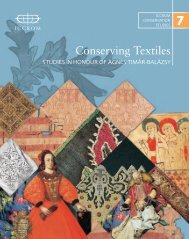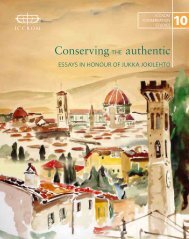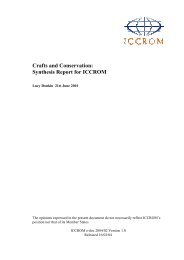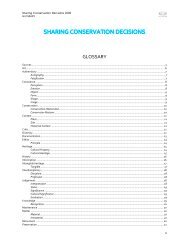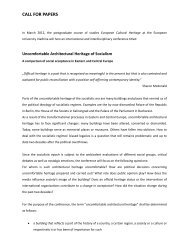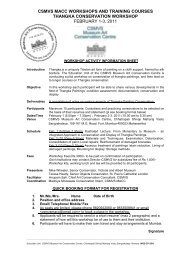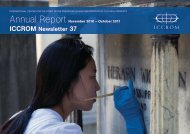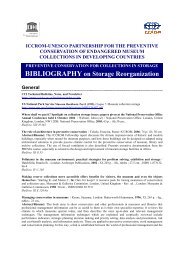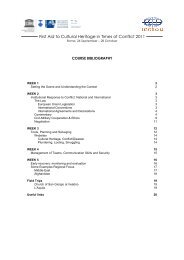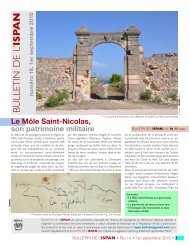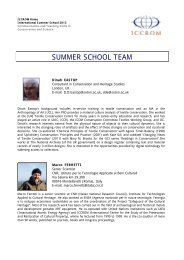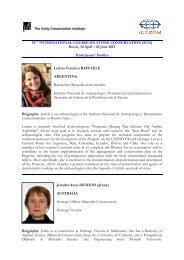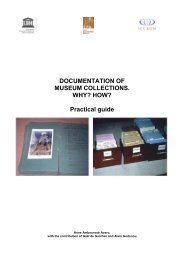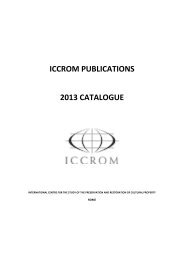part 1 - Iccrom
part 1 - Iccrom
part 1 - Iccrom
You also want an ePaper? Increase the reach of your titles
YUMPU automatically turns print PDFs into web optimized ePapers that Google loves.
Conservation of urban architectural heritage in Rosario: inventory,<br />
regulation and evaluation instruments<br />
Abstract<br />
Carolina Rainero 1<br />
Conservation of built heritage must be considered as an identity and local development factor that plays a<br />
positive role in building the urban landscape. However, urban dynamics themselves jeopardize built heritage,<br />
since building a city on an existing one implies substitutions that, in many cases, act against urban<br />
memory. This paper intends to reflect upon urban policies’ follow-up and monitoring strategies of urban<br />
architectural heritage protection and conservation in Rosario.<br />
The Urban and Architectural Heritage Conservation and Rehabilitation Municipal Program, which depends on<br />
Rosario Municipality’s Planning Office, has implemented an extensive property protection program. The<br />
first actions were focused on control of demolition files which involved heritage buildings, on elaboration of<br />
an inventory of property in the city’s central area – highly exposed to substitution given its high real estate<br />
value – and on <strong>part</strong>icipating in the elaboration of the new urban code (2008) that has used urban indicators<br />
to attempt to discourage indiscriminate substitution in heritage areas as a measure to complement direct<br />
property conservation. The state action proposes regulatory instruments that, on the one hand, regulate or<br />
limit actions on heritage and, on the other, prioritize the incorporation of heritage in the definition of urban<br />
landscape. Heritage protection is not feasible with just the elaboration of property inventories or protective<br />
regulation. These represent the reference framework and the starting point of continuous and permanent<br />
follow-up and monitoring of the actions that public conservation policies must address in relation to urban<br />
heritage interventions.<br />
Keywords: urban conservation, architectural heritage, inventory, regulations instruments<br />
1<br />
Professor of Architecture. Facultad de Arquitectura, Planeamiento y Diseño. Universidad Nacional de Rosario. crainero@sede.unr.edu.ar;<br />
carorain@hotmail.com<br />
Introduction<br />
v v v<br />
Experiences in historic cities cannot be taken as<br />
referents since they differ in nature, whether for<br />
historical, constitution or growth dynamics reasons.<br />
On the other hand, the population fails to see in heritage<br />
a wealth factor, and tends to consider heritage<br />
a load rather than an alternative for development.<br />
The city grows and is transformed and, unfortunately,<br />
irreplaceable buildings and property can<br />
be substituted in this process, giving rise to an evident<br />
contradiction. From the physical perspective,<br />
the city is being built on the existing city, but this<br />
could take place without destroying the several layers<br />
that overlap in space-time. Its unique buildings,<br />
streets and landscape as a whole make up a rich<br />
tangible heritage which, like landmarks or anchorage,<br />
account for historical continuity, provoking<br />
reflections of urban heritage and culture as regards<br />
identity, forms of evocation and memory. Therefore,<br />
it is necessary to reflect upon management, from the<br />
indirect control of urban shapes to the instruments<br />
that permit anticipating architecture — city projects.<br />
Figure1.RosarioCentral Area (Source:Arq,Carolina<br />
Rainero).<br />
1. City characterization<br />
Towards 1852, Rosario, a village of 9,785 inhabitants,<br />
became a town (Figure 1). 1 By that time, the<br />
village had extended spontaneously following the<br />
Hispanic checkerboard orthogonal tradition, from<br />
the core of the settlement made up of the chapel and<br />
Rainero, C. 2012. How to register memory? Documentation, recording, archiving and preservation of intangible cultural heritage in<br />
Venezuela. In Zancheti, S. M. & K. Similä, eds. Measuring heritage conservation performance, pp. 59-66. Rome, ICCROM.<br />
59



